All light is not created equal
All light is not created equal.
If you’ve even been under a sickly-feeling fluorescent light in a hospital or office or school, you know what I’m talking about. The bluish-greenish-white tint, the subtle flickering, the buzzing…

When you’re in that environment, faces look tired and flat and discolored. Objects in your peripheral vision vibrate slightly. Everything looks a little off.
But when you’re out on the beach on a gorgeous day, it’s the opposite. Everyone looks vibrant. There’s a feeling of visual evenness and smoothness and clarity.

Why is this?
It turns out that — perhaps unsurprisingly — light is a complex phenomenon, and our bodies, eyes, and minds are highly sensitive to its specific characteristics. All light is not created equal, and as man-made technology has progressed from fire to modern LED lighting, we’ve created a slew of variations.
Each of those variations affects us differently. Some are excellent, and some aren’t so good.
And unfortunately, I’m willing to bet that the light bulbs in your house fall in the latter category.
A full explanation of all things light would fill a textbook (or many, really). So here, I’m going to focus on what I see as the two key characteristics that are problematic in most modern lighting: its spectrum and flicker. And along the way, I’ll tell you some stories about the history of man-made lighting.
By the end, you’ll know what you need to do to make the lights in your house great. I am not exaggerating when I say that more than half the people who come to my house in the evening comment on how good the lighting is. The difference is immediately perceptible — like walking from a fluorescent-lit hospital room into a sunny day outside.
Light spectra
Our eyes are capable of visually seeing the entire rainbow spectrum — from violet to indigo to blue, green, yellow, orange, and red. Anything outside the bounds isn’t perceived by our visual system (but certainly still has an effect on us!)I covered what is beyond the edges of this spectrum in my post on EMF science..
To describe a light’s overall color and visual perception, you can plot a spectrum diagram that shows the intensity of each color of light. The colors are described by wavelengths (from very violet 380 nm to very red 780 nm). For example, here’s a spectrum diagram for a pure-blue light:
Or here’s a pure-red light:
But in reality, most light sources we see aren’t just a single color/wavelength. They’re a mix of a bunch of wavelengths which, when combined, are perceived by our visual system as a color. For example, here’s the spectrum of a warm white incandescent bulb (those old-school bulbs with a tungsten filament that heats up):
That “warm looking” light comes from the combination of a lot of red, a little orange, less yellow, even less green, and so on.
And if you were wondering about those ugly fluorescent lights we mentioned earlier, they often look like this:
Does that look weird and uncomfortable to you, with some sharp spikes? It’s not a graphical bug. That’s really what fluorescent spectra look like. Definitely a different spectrum, definitely a different visual impact.
There’s a preference point to be made here about which lights look good and which don’t. I could tell you what I like (and I will in a bit). Others may disagree.
However, there’s a very non-preferential, scientific point to be made:
Our bodies, eyes, and brains are highly sensitive to light in what are called the “photopic” and “melanopic” spectrum ranges.
Photopic light is what our visual system processes most acutely. That is, visually, we respond most strongly to green or green-yellow light.
But biologically, light in the melanopic range — blue-ish — is a trigger for circadian rhythm. Said simply, the more melanopic light, the more awake we feel. This is where we’re going to focus.
Here’s where those two ranges are — the higher the corresponding curve, the stronger our response to it. That is, in the middle of the melanopic curve (around 480nm), we have the strongest circadian response to light.
It’s reasonable to assume that this is evolved behavior. Bright sunlight — as we’ll get to shortly — has a lot of melanopic light, which triggers wakefulness (makes sense when the sun is up in the sky). Sunset and flames have very little, and this combination triggers sleep (makes sense in the evening and night).
I won’t get too far into the biological weeds here, but if you’re interested, you’re going to want to dig into “intrinsically photosensitive retinal ganglion cells” or “ipRGCs,” which are light-sensing neurons mostly in your retina that regulate your circadian rhythm, sleep, alertness, and a whole lot more.
Here’s the main takeaway I want to give you first: viewing light in the “melanopic” range — colloquially known as “blue light” — in the evening is very bad for circadian rhythm and sleep. Here are some studies.
This is why you’re told not to stare at your computer or phone right before bed (true). It’s why you see people wearing those funky orange-tinted — blue-light-blocking — glasses (yes, they work). It’s why a candlelit room feels more relaxing than a bulb-lit one.
Wait: more relaxing than a bulb-lit one? Aren’t all our houses lit by bulbs?
Yes. Nearly everyone’s house these days is lit by LED bulbs. And here’s the spectrum of a typical, normal, “warm-colored” LED:
See that blue spike? There’s a bunch of blue light in that bulb, even though it’s a “warm-looking” one.
And, combining with a diagram from above… where is the melanopic range that triggers wakefulness?
Hm. It seems that our LED bulbs have a spike of nearly exactly the color that most induces wakefulness. This is unfortunate (and sadly, true).
It means that in pretty much every modern home, when you turn on the lights in the evening, you’re beaming wakefulness straight into your eyes — suppressing melatonin production and throwing off your circadian rhythm.
We’ll get to solutions in a moment. But first, there’s an interesting diversion to chase down: why do nearly all LEDs have a spike in exactly the worst spot for us? (It’s not a conspiracy, just a nasty accident of history.)
Why blue LEDs?
I’ll keep this brief. But here’s the basic story:
LEDs — or light-emitting diodes — are tiny little devices (technically semiconductors) that, as the name suggests, emit light when current is passed through them. This is what a couple types of LEDs look like:
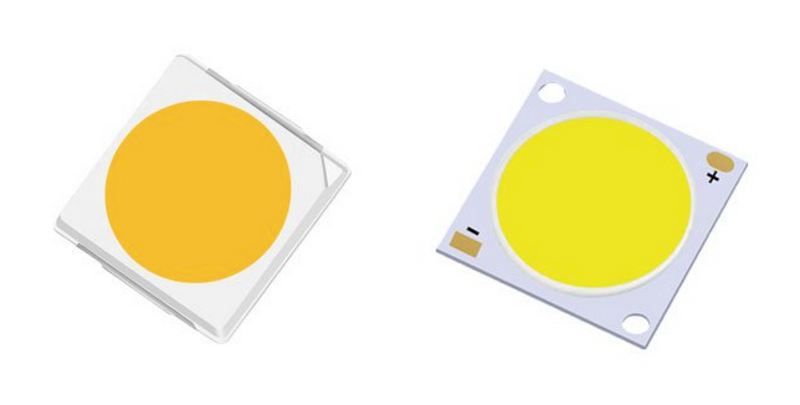
The LED bulbs in your house are actually just mostly-empty chambers with a bunch of these diodes inside of them. When LED bulbs were invented, we decided to make them mostly look like traditional bulbs in order to maintain backwards-compatibility with existing fixtures and designs, even though the shape isn’t necessary. Here’s a couple photos of an LED bulb I broke apart:
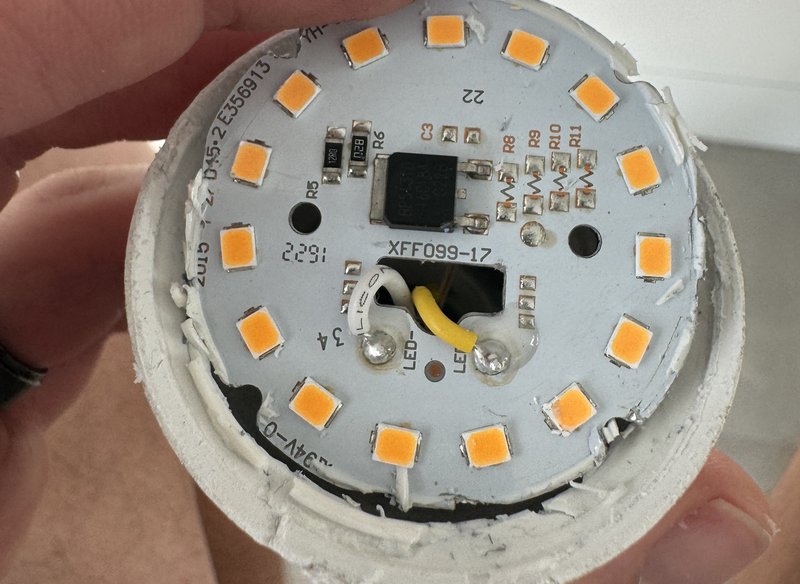
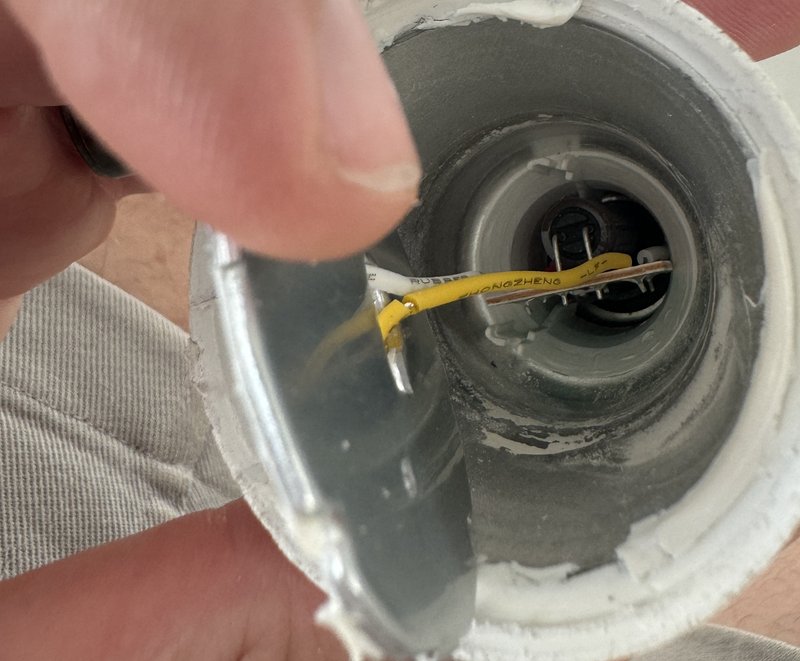
The light-emitting diodes are the tiny little squares on there. They emit all the light.
And the inside of those little square LEDs by themselves, in general, only emit a very narrow spectrum of light. They’re like the diagrams we showed way up top:
Of course, bathing your house in pure green or red or blue light would not be a pleasant experience. So instead, we need to find a way to turn that very pure single-colored light into something that looks “white-ish.” (There’s a range of what white-ish means, which we’ll cover in a bit. You’ll see bulbs labeled “warm white” or “cool white” and so on. But most any light you’d buy for your house is intended to put off “white-ish” light — it’s what we’re used to.)
The primary way we go about turning pure-single-colored-light into white light is with something called a “phosphor.” This is basically a thin layer of chemical compounds that covers the light-emitting diode. When the light hits (or “pumps”) the phosphor, the phosphor lets some of it through, and absorbs and re-emits the rest of the light at different wavelengths. In this way, you can “spread” the spectrum of light from a single color to multiple colors — allowing the creation of white-looking light.
The orange coating on those LED chips in the images above is that phosphor.
What we perceive as “white” light is really a mix of all the different colors under the hood. There’s no “white wavelength” — but when we visually process an appropriately-balanced mix of most of the colors, we see it as white.
Here’s the rub, though: phosphors can only spread wavelengths longer. That is, you can’t use a phosphor to take red light (long wavelength) and spread it down to green (shorter wavelength). This has to do with the photon energy of the light (again, for more electromagnetic radiation background — of which visual light is an example! — see my older post). The phosphor can’t add photon energy, so it can’t spread a certain light spectrum to higher photon energy (shorter wavelength) colors. It can only step down the photon energy, going to longer wavelengths.
And that means that if you want to create a balanced-looking spectrum across most of the human visual field, you need to start with a low-wavelength light like violet or blue. That way you can spread the light longer and cover the whole spectrum, getting you to perceived-to-be-white light.
The first light-emitting diodes people created produced longer-wavelength light, like red. So we couldn’t use them as the foundation for producing white light.
It’s unfortunately not trivial to make new types of LEDs. Here’s a good video on the history. So it’s not like one day scientists realized the challenge above and the next day they had white-looking LEDs.
It took awhile, but in the early 1990s they managed to create a blue LED using mostly gallium nitride. Those scientists won a Nobel Prize for doing so.
And then, suddenly, we could create white-ish LEDs by putting certain phosphor mixes on top of those short-enough-wavelength blue LEDs. This began the wave of LED lighting across the world.
But — back to where we started this digression — this was a very unfortunate coincidence. Why? Because that blue they created turned out to be in the middle of the melanopic spectrum.
And because phosphors generally let a good chunk of the base light through (even if they mix it visually with other colors), that means that we got saddled with blue light coming from our LEDs. That blue light shines straight through the phosphor, hits our ipRGCs, and messes with our circadian rhythm. Oops.
It’s really a grand coincidence of science (and of the nature of semiconductor bandgaps, if you want to get technical about it). I sometimes wonder if there is some grander cosmic reason for this coincidence — perhaps tying together those gallium nitride semiconductor bandgaps, the spectra of the sun and how its emissions are formed, and the semiconductors that make up our bodies… but that’s for another day.
As a final aside, you may wonder: why not just use violet LEDs? Then you could still smear up through the longer wavelengths, but have your main LED spike be outside of the blue/melanopic range.
This is possible, and in fact, one of the Nobel Prize-winning inventors of the blue LED started a company called Soraa to make these. Soraa got bought by a larger lighting manufacturer called Korrus, and they are doing some really, really cool work to bring violet-pumped LEDs to market.
It’s just way harder and costlier to do violet-pumped LEDs well. It took a bunch more science to make them efficient and stable, and the processes are still far less refined than the industry-standard blue-pumped LEDs. Plus the phosphors need to be more complex and can have stability issues because of the increased energy of the violet LEDs. I applaud Korrus/Soraa’s work and am curious to see how it all develops, but I think we are a long way away from the standardization of non-blue LEDs.
(Plus, there are some questions about whether violet light is actually that much better than blue light — it’s an active scientific debate.)
And then there’s flicker
So: most LEDs have this spike of light specifically in the range that disrupts our sleep and circadian rhythm. Not great. But if that’s not enough to convince you to make a change, I have one more thing to tell you about:
Flicker.
You have probably seen light bulbs that perceptibly flicker — maybe those fluorescents we mentioned earlier, or just random other bulbs. Sometimes the flicker is overt, where you can see it blinking off and on quickly. But more often, it’s subtle — maybe you see some visual pulsing, or you just have a vague sense of some flickery-ness. It’s often right on the edge of perceptibility.
Even when not perceptible to the human visual system, flicker can impact health, causing eyestrain, headaches, fatigue, and cognitive disruption. Here’s some background reading.
There’s a lot that goes into flicker, but here’s one of the key causes: our electrical grid runs on what is called “AC” power, or “alternating current” power. That’s in contrast to “DC” or “direct current” power. (And yes, that’s where the name AC/DC comes from.)
AC power is another textbook-worthy topic, but basically means that in an electrical circuit like the one powering your light bulbs, the direction the electrical current flows switches back and forth many times each second. In the US, it switches at 120 times per second (60 full cycles of two directions; 120hz), and in a lot of other places, it’s at 50 full cycles, or 100Hz.
In theory, roughly, this suggests that absent anything to prevent it, light bulbs should fully turn on and off 60 times per second.
Various types of light bulbs deal with this differently.
For example, incandescent bulbs function by simply heating up a piece of wire until it emits light. Even though the AC power is pulsing back and forth 60 times per second, the wire itself stays hot — it’s not like it cools down (shutting off the light) and then heats back up (turning on the light) every second. Think about a pan on the stove — even when you turn off the flame, the pan stays hot. In the same way, incandescent bulbs just stay on.
The alternating current power does have some effect on incandescent bulbs, causing them to very slightly flicker. But it’s not significant.
But LEDs function differently. The diode itself requires DC power to run, not AC power. And to solve this, LED bulbs have a circuit board and some electrical components inside the bulb — a “power supply.” Here’s a photo:
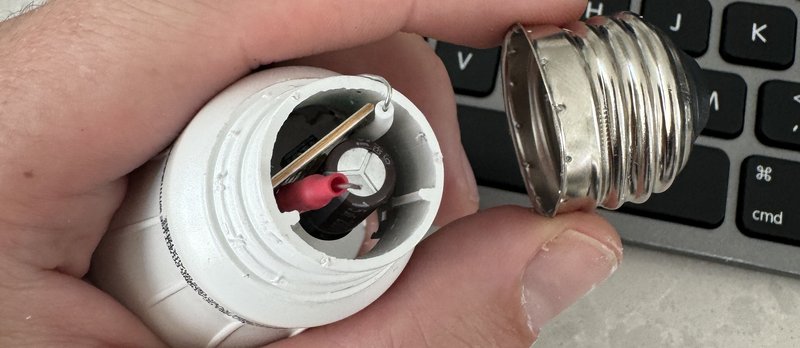
These electronics convert the AC power from the electrical grid into DC power for the LED. In theory this can be done very effectively.
But in practice, it rarely is. Manufacturers use cheap power supplies — an issue we’ll get back to later in this article too — and it often creates severe “flicker.” The electronics, rather than smoothing out the current and stepping the voltage appropriately, do a good enough job to make the light work, but let through a bunch of current variation from the AC power and the LED flickers on and off constantly — right at the edge of human perception.
There are also other factors, including the common use of Pulse Width Modulation (PWM) for dimming, which effectively flips on and off the bulb rapidly to make it appear dimmer than it really is.
Here’s a fun experiment: take your phone, open the camera app, and put it on slow-motion mode. Then go and take 2-second videos of a bunch of LED lights (most of the lights you’ll find these days). I bet you’ll find something flickering when you play the videos.
And no, what you see is not an artifact of the camera — that’s actually happening. As mentioned above, LEDs flicker at 120Hz (120 times per second). My iPhone’s slo-mo mode takes video at 240 frames per second. That means the framerate is fast enough to capture the flickering. You can verify all this with a flicker meter (or a spectrometer equipped with flicker readings).
This is the second big issue with most LEDs. Not only do they beam blue light into your eyes, but they’re constantly flickering. Being bathed in those two effects is not good for us.
Just like with the blue light: it is possible to make flicker-free (or at least nearly-free) LEDs. Some manufacturers do it. Even some batches of typical LEDs will be fine — but you just never know until you test that specific batch.
So what should I do?
My simplest and most straightforward recommendation: at least for evening lighting, switch to incandescent bulbs (or halogen bulbs, which are a type of incandescent).
Yes, incandescent bulbs are technically illegal to sell in the US right now (which is crazy, although may be changing soon). See a previous article for more on this. But you can still find them.
There are also some good LEDs out there.
The best I have found are Yuji bulbs — they have a variety of different spectra for daytime or evening. Healthy Home circadian bulbs are also solid and can transition between daytime and evening spectra.
There are a variety of metrics that report how much the light will stimulate your circadian rhythm, and they are reported in varying ways. If you can find a reported mDER (Melanopic Daytime Efficacy Ratio, referred to as M/P ratio type 4 in the linked document), that is typically the most useful metric. Keeping it below 0.35 is best for evening lighting.
In practice, what we really care about for circadian stimulation is “melanopic lux,” but that takes into account how bright/dim you have the light and where you are relative to it in addition to its spectrum, and so can’t be straightforwardly reported by manufacturers. mDER is the most useful reported metric I have found, and there are well-researched recommendations for what levels are acceptable in the evening.
Plus: try using blue-light-blocking glasses for an hour or two before bed (the real ones with orange-colored lenses). For most people, this makes a huge — and immediate — difference in how quickly they fall asleep and how relaxed they feel. It’s worth the experiment.
In defense of incandescents
People will say that incandescents are energy-inefficient and die quickly — that’s why we all switched to LEDs! And there’s certainly some truth here: incandescents do consume more electricity when in use (you can see it labeled on the package — Incandescents are often 40-100 watts, and LEDs are usually less than 15 watts.).
They also do tend to die more quickly. But the difference isn’t nearly as stark as most people think, for three reasons:
- Old narratives, starting with the Phoebus cartel
- Dimming can dramatically increase incandescent lifespan
- Most LEDs die faster than promised
The Phoebus Cartel
In the 1920s and 1930s, General Electric, Philips, and several other leading bulb manufacturers created the Phoebus Cartel (or, uh, the Phœbus S.A. Compagnie Industrielle pour le Développement de l’Éclairage, French for “Phoebus Industrial Company for the Development of Lighting”).
At the time, incandescent bulbs lasted about 2,500 hours. These enterprising manufacturers decided it would be better for all of them if the bulbs only lasted for 1,000 hours instead, so that customers would need to buy twice as many.
They even inspected each others’ bulbs and were fined when they made ones that lasted longer than 1,000 hours.
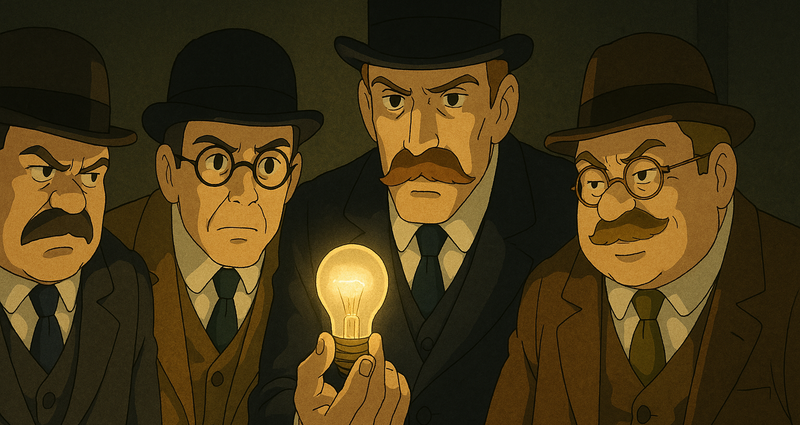
The Phoebus Cartel is long gone, but its spectre and narrative remains. Today there exist long-life incandescent bulbs, but in most people’s minds, incandescents die near-immediately.
Dimming
And that brings us to our second point: incandescents can last a long time — especially if you dim them!
Because of an interesting physical dynamic of filament-based bulbs called “lamp rerating,” even a slight dimming of an incandescent bulb dramatically lengthens its lifespan. Dimming a bulb by just 5% will make it live 85% longer. Dimming it by 10% will make it live 255% longer!
(If you want to dig into this more, look up lamp rerating and “rerated life” — you’ll see that the rerated life of a filament bulb is roughly the ratio of the original voltage to the dimmed voltage, raised to the twelfth power. That is a big exponent!)
So yes, maybe your incandescent is rated for 2,000 hours. But by having it on a dimmer, you could turn that into 4,000 or even 8,000 hours.
Now, does the same dynamic apply to LEDs? Not really, which brings us to our final point…
LEDs do die
Incandescents die when their filament burns out. But LEDs, in general, do not die because the light-emitting diode itself dies. They die because the other electronics in the bulb fail.
Remember how we talked about those low-quality electronics in the base of the bulb earlier? Those same electronics are the most likely part of the LED bulb to die. The LED itself can last forever (many tens of thousands of hours), but the rest of the electronics can’t.
You’re rolling the dice, really, with LED bulbs and their lifespans. Some batches are great and will last forever. Some aren’t (even sometimes of the same type!). And those not great ones can die even faster than an incandescent!
In general, what happens is that the components end up overheating and dying. If you have the bulb in an enclosed fixture, the problem tends to happen even faster (many LEDs actually aren’t rated to be installed in enclosed fixtures).
So net of everything: yes, LEDs tend to last longer than incandescents. But the difference is not as stark as most people think.
Between the century-long narrative hangover of the Phoebus Cartel, the multiplicative life-extension of dimming and lamp rerating for incandescents, and the realities of low-quality LED bulb components: it’s not the 10x or 100x difference in favor of LEDs that everyone thinks it is.
Other characteristics
There are a couple other attributes worth looking out for: color temperature and color rendering index (CRI).
Color temperature refers to the “warmth” of the bulb. Somewhat confusingly, the higher the temperature, the “cooler” the bulb. Bright white daylight bulbs are around 5000K, “warm” white bulbs tend to be around 2700-3000K.
Color temperature is correlated with the amount of blue light, but isn’t a perfect map. If you’re looking for evening lighting, I like warmer bulbs (so in the 1500-2700K range). If you’re looking for daytime lighting, I like cooler bulbs. This mimics natural sunlight.
Here’s a diagram from Simon Sarris:

CRI is a little tricky (for more, see this article). For bulbs that are designed to eliminate certain parts of the spectrum — like Soraa bulbs without blue light — they will have a low CRI as a byproduct of that choice. But, in general, absent some specific reason for CRI to be low, a higher CRI is better. It’s a flawed metric, but it’s the one all the manufacturers use, so unless you’re willing to deep dive into color-rendering alternatives, it’s fine to look at.
Incandescents have a CRI of 100 (great!). If you’re going with LEDs, I’d generally try to stay above 95-97 if possible. The better the CRI, the better (in general) everything will look.
Light height
Last, one interesting note: there’s some research that suggests that the height of light sources matters for impacting our circadian rhythm and sleep. Light coming from low in your visual field helps you go to sleep, light coming from high in your visual field makes it harder to go to sleep.
This makes rough sense from an evolutionary perspective: low visual field lighting (sun setting, fires) is what would happen in the evening. High visual field lighting (the sun high in the sky) would happen midday, when wakefulness was required.
How does this work? Those ipRGC cells I mentioned earlier are clustered in a place in your eye (your lower retina, corresponding to the upper visual field) that makes you especially biologically sensitive from a circadian perspective to light from the top half of your visual field.
In practice, I suggest that for evening lighting, you use lamps rather than overhead lights. During the day, overheads are fine (even good!).
In summary
- Try out incandescents in lamps for evening lighting, with no overhead or LED lights in the hours before bed.
- Wear blue light blocking glasses for the couple hours before you go to sleep.
- Maybe even try full-spectrum sunlight-mimicking bulbs during the day.
Anecdotally: once I changed my lights, not only did I feel better and more relaxed in the evenings, my sleep patterns totally changed. I started to naturally get much more aligned with the sun’s rise and fall, and my sleep felt much deeper. It’s been one of the most impactful changes I’ve made.
There’s even more to cover here, and I perhaps will in future posts, including:
- the key role of near-infrared light in our light sources (if you just get incandescents, you’ll be covered on this front — the lack of NIR in LEDs is yet another issue with them)
- why “light therapy” devices are mostly ineffective despite relying on a good idea (they’re underpowered by several orders of magnitude)
- and more…
Spot anything that needs to be clarified or corrected? Email me!
And if you’re curious to learn more about the health of your home’s lighting (and air, water, EMFs, and more), check out Lightwork Home Health, which I co-founded to help people live in healthier homes…
Looking for more to read?
Or, more on light:
Tom Scocca wrote a really excellent piece in New York Magazine called “The New Light is Bad.” It’s worth a read.
Russell Graves’ blog has a number of excellent posts on LEDs and lighting in general. I’d start with “How Your LED Lights and Screens are Killing You.”
Simon Sarris also has a good piece on lighting in homes.
And for even more...
Want to hear about new essays? Subscribe to my roughly-monthly newsletter recapping my recent writing and things I'm enjoying:
And I'd love to hear from you directly: andy@andybromberg.com